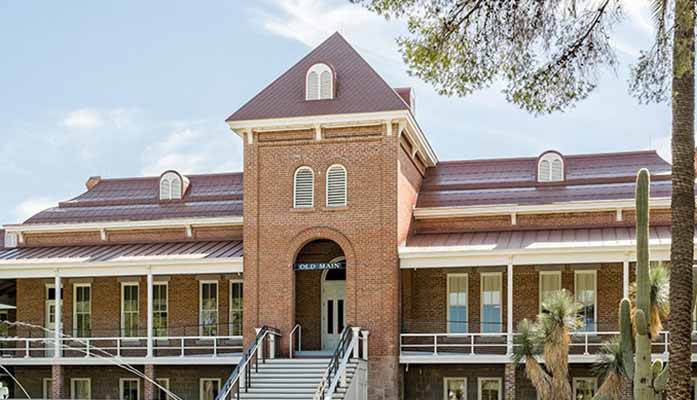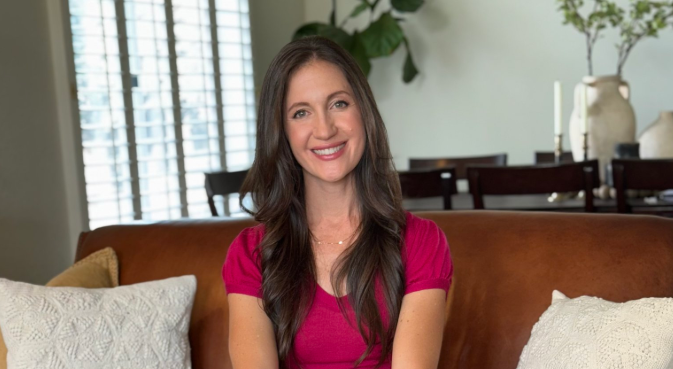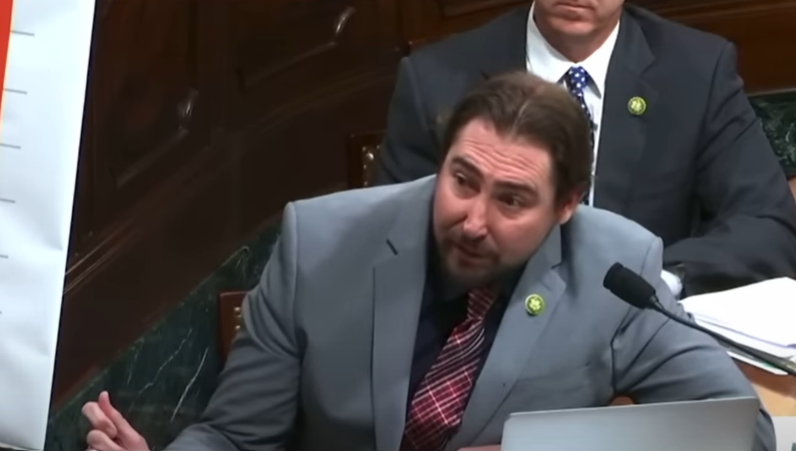
by Matthew Holloway | Aug 27, 2025 | Education, News
By Matthew Holloway |
Former University of Arizona (U of A) ethics professor Daniel Grossenbach is suing the school with the help of Liberty Counsel, after being fired for publicly advocating for his parental rights at Catalina Foothills School District (CFSD) meetings.
Grossenbach, a CFSD parent and resident, is the founding member of ‘Save CFSD,’ a “non-profit organization focused on educating parents about school board policies and issues and fundamental parental rights.” According to the lawsuit, he was “unceremoniously terminated” by U of A leaders, “at the demands of internet trolls’ intent on silencing his speech.”
In a press release issued Friday, Liberty Counsel announced the lawsuit on Grossenbach’s behalf. The Christian legal ministry explained, “In 2023, Grossenbach spoke several times at school board meetings, which [were] attended by hundreds of concerned parents, and delivered two-to-three-minute, pre-written speeches. He routinely included a disclaimer that he spoke for himself and not for his employer, and expressed without hate, slander, or violence how the district’s policies violated parental rights.
“The lawsuit then states that ‘anti-religious zealots turned digital critics’ coordinated over social media to silence Grossenbach and SaveCFSD by getting him fired from his job. Subsequently, numerous anonymous complaints were filed against him with the University of Arizona encouraging the university to discipline him for speaking out about his rights and beliefs.”
Liberty Counsel revealed, “In November 2023, the university informed him that it would not be renewing his part-time teaching contract for the following Spring ethics courses citing it had received funding for a full-time faculty member. However, the university never hired a full-time professor nor offered his ethics course the following Spring. In fact, the university posted advertisements soliciting resumes for additional part-time professors meeting Grossenbach’s exact skills and experience to teach similar courses he had been teaching for years.”
The attorneys argue that despite Grossenbach’s good performance and positive reputation, U of A terminated his employment “after discovering that he was an outspoken Christian advocating for change within his local school board to protect his family.” They claim the university subsequently stalled the disclosure of public records regarding his termination for 239 days in violation of Arizona law.
“[The University of Arizona’s] actions have inflicted irreparable damage to Professor Grossenbach’s professional career and reputation, ended his academic pursuit of a doctorate degree, decreased his earning potential, and reduced his income,” wrote Liberty Counsel. “Further, when Professor Grossenbach was terminated, he lost a potential textbook publishing deal, furthering his financial loss and reputational damage.”
According to the lawsuit, Grossenbach was terminated on November 30, 2024, after serving in his role for over three years “on the basis of complaints lodged by anonymous online censors targeting his constitutionally protected speech regarding his sincerely held religious beliefs, in his private capacity, separate and apart from the workplace.”
The professor filed a charge of discrimination with the Equal Employment Opportunity Commission and obtained a Notice of Right to Sue on May 25, 2025.
“Professors at public universities and colleges do not shed their constitutional rights to free speech and religious exercise when they work for a university,” said Liberty Counsel Founder and Chairman Mat Staver. “Professor Daniel Grossenbach engaged in constitutionally protected speech, religious expression, and religious exercise and was speaking on matters of public concern regarding his faith, morality, and the community. The University of Arizona cannot fire a professor for his protected speech. Viewpoint discrimination is unlawful and violates the First Amendment and religious discrimination violates Title VII.”
Liberty Counsel is seeking a permanent injunction to declare the university’s Nondiscriminatory and Anti-Harassment Policy and Statement of Professional Conduct illegal and unlawful, along with compelling U of A “to reasonably accommodate the religious beliefs and practices of its employees.” The lawsuit also asks the court to reinstate Grossenbach to his former position, restore his benefits, and award damages.
Grossenbach’s efforts with ‘Save CFSD’ and exposure of controversial whistleblower audio released in May have been reported on by AZ Free News. The Professor also penned an op-ed on AZ Free News in October 2024 discussing his termination.
Matthew Holloway is a senior reporter for AZ Free News. Follow him on X for his latest stories, or email tips to Matthew@azfreenews.com.

by Matthew Holloway | Aug 26, 2025 | News
By Matthew Holloway |
Joseph Sanberg, co-founder of Aspiration Partners and a prominent California Democrat who has donated to Gov. Gavin Newsom, pleaded guilty Thursday to two counts of wire fraud. Sanberg, who launched the company with former Arizona Democratic Chairman and CD1 Congressional candidate Andrei Cherny in 2013, faces a maximum penalty of 20 years in prison per count for “defrauding multiple investors and lenders” in a carbon credit purchasing scheme.
According to the Department of Justice, Sanberg, “devised a scheme to use his role as a co-founder and board member of Aspiration as well as his shares of company stock to defraud various lenders and investors.”
All told, Sanberg pleaded guilty to attempting to bilk investors of as much as $2 billion, the company’s proposed valuation. The FBI and the U.S. Postal Inspection Service conducted the investigation.
From 2020-21, Sanberg and fellow board member Ibrahim Al Husseini “fraudulently obtained $145 million in loans from two lenders by pledging shares of Sanberg’s Aspiration stock.” The two subsequently falsified Al Husseini’s bank and brokerage statements to inflate his assets by tens of millions of dollars for the purpose of securing loans.
Cherny left the company in mid-October 2022, according to Forbes, following “a rift” that developed between him and Sanberg and a failed attempt to take the company public. At the time of his departure as CEO, the fraudulent activity had been ongoing for approximately two years.
The SEC complaint revealed a text message from Sanberg to Cherny in 2020 in which he said, “If you don’t get me the money tomorrow we are all f…ed. Get me the money. Your turn to figure it out like I have for so long. Wire it to the [Sanberg-entity] account. If you don’t then [the lender] will foreclose. This will give you a good taste of what I have to experience every day. I hate you and I hate this company and I don’t want to work anymore with you [ ]. You are so oblivious to what you’ve forced me to have to do.”
“This is a case about greed and abuse of trust,” said Assistant Director Jose A. Perez of the FBI Criminal Investigative Division. “Today’s guilty plea is a direct result of the commitment by the FBI and our law enforcement partners to hold those accountable who set out to defraud victims and undermine our financial system. The FBI will continue to work with our partners to ensure this kind of malicious behavior is investigated and stopped.”
When the investigation was launched by the Justice Department and the Commodity Futures Trading Commission following a 2021 ProPublica investigation, Cherny, deep in his failed campaign to unseat Rep. David Schweikert, defended his work at Aspiration. Cherny told ProPublica that only 12 million of the 35 million “cumulative total of to-be planted trees” had been planted at that time, noting the turnaround on a new planting was about 18 months.
“I have spent more than 25 years working to combat the climate crisis and am proud of the work I did to promote cutting-edge solutions at Aspiration,” Cherny said. “The carbon removal credit industry is an emerging industry and deserves to be regulated and scrutinized to ensure it is as effective as possible.”
He added, “I have no knowledge whatsoever of any wrongdoing at Aspiration and will fully cooperate with this inquiry.”
According to the SEC complaint, “To make it appear as though Aspiration’s business was rapidly growing, Sanberg recruited friends, associates, small businesses, and religious organizations and presented them to Aspiration as bona fide customers who were fully committed to paying large sums of money for the tree-planting services.”
The complaint continued, “Through his fraud, Sanberg raised more than $300 million from investors who falsely believed Aspiration had a thriving environmental sustainability services business.”
“The defendant didn’t just bend the truth, he built a business on a lie to boost the company’s value and line his own pockets,” said Inspector in Charge Eric Shen of the United States Postal Inspection Service (USPIS) Criminal Investigations Group. “The Postal Inspection Service will go after this kind of calculated deception. No matter who you are, you will be brought to justice.”
Matthew Holloway is a senior reporter for AZ Free News. Follow him on X for his latest stories, or email tips to Matthew@azfreenews.com.

by Matthew Holloway | Aug 25, 2025 | News
By Matthew Holloway |
Following the announcement of her candidacy for the Mesa City Council seat currently held by Julie Spilsbury, who is facing a recall election, Dorean Taylor (DT) was willing to answer a few questions for AZ Free News to provide voters with a background on her and her candidacy. Taylor called out Spilsbury for repeatedly voting “to harm the people of Mesa with woke and ineffective government policies that violate our deeply held community principles.” She also placed blame on Spilsbury for increases in homelessness and utility costs.
Taylor announced her candidacy in July after Councilwoman Spilsbury faced serious challenges to her self-proclaimed status as a Republican for her enthusiastic endorsements of Vice President Kamala Harris in the 2024 Presidential Election as well as endorsements from prominent Arizona Democrats U.S. Rep. Greg Stanton, Arizona Secretary of State Adrian Fontes, and U.S. Sen. Ruben Gallego.
Asked to provide a background on herself, Taylor told us:
“I’m originally from the beautiful sunny state of Florida. My family still resides on the East Coast, and I enjoy flying back to see them and visit any time I can. I moved to AZ to attend the same amazing church I still attend today and complete my bachelor’s degree. While I was in school and working full time, I met the love of my life, a Mesa native! We got married, started life together in Mesa, and are still living here today. I’ve come to know and love my community here and have lived in or near District 2 since 2010. Our first home was at Lindsay and Brown. One of my favorite things about Mesa is the small-town feel you can experience in a large suburb. For example, my neighbors will ride their horses down the street and wave to us while we sit on the front porch, but just down the street is a shopping center and public parks. It’s incredible.”
Taylor then answered some questions regarding her campaign, her motivations, and what differentiates her from her opponent.
AZFN: What inspired you to join the race for City Council?
DT: “Thank you for asking. I spoke on behalf of my household and my neighbors, witnessing others who felt the same way speaking up too, and watching all of us be politely ignored. It’s become clear to me that its long overdue for the great people of Mesa District 2 to have principled, honest, common sense leadership on the City Council — representation that actually cares about implementing policies that will improve the lives of the people who call our city home. I’m running to ensure that we have better roads, a safer community, we work to end the homelessness epidemic, and reduce taxes and fees while making our government smarter and more efficient.”
AZFN: How do you differentiate yourself from Councilwoman Julie Spilsbury?
DT: “Our core principles on what drives us to action are different. Unfortunately, my opponent has repeatedly voted to harm the people of Mesa with woke and ineffective government policies that violate our deeply held community principles. She has not remained non-partisan. My opponent has supported policies that have led to an historic epidemic of homelessness on our streets, wasteful spending on pet projects, an increase in utilities, and a currently proposed more than 40% increase in Mesa water rates — Ms. Spilsbury has broken her commitments to the people who elected her, and she has lost the trust of our community. Over five thousand residents signed to recall her. The people have spoken. I’m running to restore honest, objectively principled, commonsense leadership in District 2. I will honor the code of ethics.”
AZFN: What are your top policy priorities once you take office?
DT: “My priorities are simple and align with the priorities of the people I am running to represent — lower taxes and cost of living, smarter and efficient government, safer neighborhoods, better roads that allow for less congestion and faster commute times, and ending the homelessness epidemic that has plagued our streets these past few years. The people of Mesa are incredible and compassionate. They want a representative government that works for everyone, and when I’m elected, that’s exactly what I’ll aim to deliver. One of my first goals is to send out communication to my district to keep residents informed of what is upcoming and to host townhalls for them. People want honesty and government transparency.”
Matthew Holloway is a senior reporter for AZ Free News. Follow him on X for his latest stories, or email tips to Matthew@azfreenews.com.

by Matthew Holloway | Aug 25, 2025 | News
By Matthew Holloway |
Congressman Eli Crane (R-AZ02) announced Friday that he has signed on to Rep. Abe Hamadeh’s ‘Preserving and Protecting the Integrity of American Elections’ Act, known as H.R. 2499. The bill is designed to codify President Donald Trump’s Executive Order 14248, which enhances U.S. election security by requiring proof of citizenship for voter registration, restricting mail-in ballot deadlines, and prioritizing enforcement against non-citizen voting.
The bill further mandates that states require proof of citizenship in the form of a government-issued ID on voter registration forms, orders the Departments of State, Homeland Security, and Social Security Administration to provide federal database access to states for determining voter eligibility, and requires a single Election Day deadline for vote tabulation. Each measure will carry the threat of withdrawn federal funding in the event of non-compliance.
In a post to X, Crane wrote, “Proud to cosponsor @RepAbeHamadeh‘s bill to codify President Trump’s executive order on election integrity. Arizonans have witnessed poorly-run elections firsthand, and this legislation addresses key vulnerabilities. We must have an efficient and trustworthy process.”
After introducing the bill, Hamadeh said in a statement at the time, “The American people deserve better. They deserve to know that their legally cast ballot is counted and accounted for. I am disappointed, but obviously not surprised that Mayes and Fontes seek to thwart the implementation of commonsense safeguards of democracy.”
He added, “As a trusted advisor once said to me, ‘election integrity never disenfranchised a single soul, but a single act of election fraud disenfranchises us all.’”
In a press release, he added, “In Arizona, we have seen what the mismanagement of voter rolls, failed election infrastructure, and corrupt courts can do to destroy voter confidence and faith in our system overall. We are taking swift action to rebuild citizens’ trust in our elections through comprehensive and meaningful election integrity legislation.”
In a post to X, the Congressman observed, “Many people say we should focus on the future and move on from 2020 and 2022… How could I(?) [K]nowing what I know? Our elections have been hijacked, they’ve been corrupted, and the American people deserve justice. It can never happen again. Election Security IS National Security.”
Matthew Holloway is a senior reporter for AZ Free News. Follow him on X for his latest stories, or email tips to Matthew@azfreenews.com.

by Matthew Holloway | Aug 24, 2025 | News
By Matthew Holloway |
While Arizona is still wrangling with the aftermath of major wildfires in the North, Governor Katie Hobbs headed to Nantucket, Massachusetts, to wine and dine out-of-state Democrat super-donors paying up to $5,500 a plate to meddle in the politics of the Grand Canyon State. The fundraising event was reportedly led by a former Ambassador whose nomination was nearly scuttled by allegations of antisemitism.
MSNBC Contributor Teddy Schleifer shared an invitation to the event in a post to X.
Tyler Bowyer, COO of Turning Point Action, lampooned the move in a post to X, writing, “another Arizona Democrat running an East Coast fundraiser.”
According to the post, the event was organized by a “host committee in formation,” which included prolific Democrat fundraiser Elizabeth Bagley, former Ambassador to Brazil under President Joe Biden and former Ambassador to Portugal under President Bill Clinton.
Bagley’s Senate confirmation was stalled in 2022 in the Senate Foreign Relations Committee on grounds of antisemitism allegations after the Washington Free Beacon found a 1998 interview in which she complained about “the influence of the Jewish lobby because there is major money involved.” She added, “The Democrats always tend to go with the Jewish constituency on Israel and say stupid things, like moving the capital to Jerusalem always comes up.” She claimed support for these Israel-related issues is due to “the Jewish factor, it’s money.”
Both Democrats and Republicans in Congress at the time were highly critical of Bagley for her remarks, to which she responded, “I regret that you would think that it was a problem. I certainly didn’t mean anything by it. It was a poor choice of words, but it was something that the interviewer had asked me, prompted by something about politics.”
Given Hobbs’ recent controversy involving the Jewish community and her veto of the Antisemitism in Education Act, which dealt with educators “promoting antisemitism or forcing students to support antisemitic viewpoints,” it is striking that Hobbs would participate in a fundraiser involving such a figure.
Matthew Holloway is a senior reporter for AZ Free News. Follow him on X for his latest stories, or email tips to Matthew@azfreenews.com.





